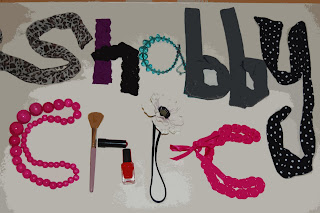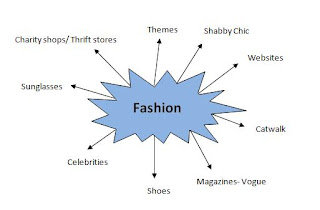Opening Titles
I produced this stop motion animation using an SLR digital camera placed on a tripod; taking individual shots of the items of clothing being moved and then repeating the process until I had an entire sequence. Then I imported the photos onto windows movie maker and adjusted the picture duration so that it would last for 0.125 seconds, therefore making a fast transition from photo to photo so that the clothing looks animated. I added 10 extra frames that I edited on Adobe Photoshop using the Cut out effect. Over the orignal layer I added the edited layer and adjusted the opacity so that it gradually increased and on the final frame in the sequence the opacity is at 100%.
Here is the first frame from the sequence
Here is a frame in the sequence towards the end, when the editted layer is 50% opacity over the original layer
Here is the final frame in the sequence

Below is the final product
Interviews
Here are the interview questions that we put together to get peoples different view points on how much you have to spend to be fashionable:
Lisa- wears mostly clothes from a charity shop
Why do you buy clothes from charity shops?
What do you look for when going to charity shops?
Do you own more charity shop clothes than high street?
How much do you spend on charity shop clothes a month?
Who are your fashion influences?
Does music also influence your fashion sense?
Do you think there is prejudice about charity shop clothes? Why do you think this is?
Can you talk us through your wardrobe please?
Mel- wears mostly designer/ high street brands
Why do you buy your clothes from Designer stores?
What do you look for when going to designer shops?
Do you own more designer clothes than high street?
How much approximately do you spend on designer clothes a month?
Who are your fashion influences?
Does music or any of your hobbies influence the way you dress?
Do you think there is pressure within society to have the latest trends and designer makes?
Would you feel self conscious walking down the street in charity shop clothes?
Can you talk us through your wardrobe please?
Interview questions for Neil the designer at Repooc couture
- Where do you get inspiration for your designs?
- Do any high street or designer stores influence your designs?
- Have you ever bought clothes from a charity shop?
- Do you think that there are pressures within society to own designer brands and to be on trend?
- You said on your website that you believe the fashion world is being dominated by more and more high street giants- can you explain why you think this?
Interviews on the Highstreet
- What do you associate with the phrase 'Shabby Chic'?
- Where do you shop for clothes? Why?
- Would you shop at a charity shop? Why?
- What do you think of what I'm wearing?
- What if I told you that it only cost £4 from a charity shop?
Filming
I have participated in the whole of the filming process:
· First we went to Liverpool and filmed 14 minutes worth of footage tracking forwards through Liverpool city centre. This footage will be in fast motion to establish the place that our vox pops/ interviews with the general public took place and also to show the wide variety of clothes shops available.
· I also took photos of shop logos for the montage at the beginning of the programme.
· Then on another day we went to Repooc Couture a boutique in Liscard to interview Neil a designer that produces all of the clothes in Repooc. We also filmed the cutaways of newspaper clippings and clothes rails.
· I went to Liverpool and filmed a cutaway of people’s shopping bags.
· We all went to Liverpool on another day to film interviews with the general public about where they shop and what they think of charity shop clothes. We also went to Oxfam and filmed cutaways of the vintage clothing and the logo.
· We filmed an interview with Lisa Smedley a great supporter of charity shops who wears mostly second hand clothes. However we had to film this interview again as the framing was wrong and the footage pixelated when we tried to capture it.
· I filmed still images of Neil and celebrities wearing his brand to use as cutaways.
Voice Over
Chelsea wrote the first draft of the voice over script which contained ideas for each section; I then made a second draft altering the style and mode of address. I went through it with my teacher to see if it would help bind the footage together and display our overall message and viewpoint.
We estimated that the voice over should consist of approximately 3 words per second, therefore I had to time and alter the voice over script to see if it would fit in with the footage.
Voice over script
approximately 3 words per second
Tracking shot- (38 secs – 114 words)
We live in a society gripped by the recession- so why is it that so many people still spend so much on clothes? There are other alternatives such as shopping in charity shops were you can find cheap, vintage, and unique clothing. It is possible to spend a little and yet look like you have spent a fortune.
However there is a growing trend for charity shop fashion which has produced the new phrase Shabby Chic- but do the people know this?
(98 words)
Zoom in on Oxfam Vintage logo (5 secs - 15 words)
It would seem that there is a stigma attached to charity shops which mean that people still don’t consider them an option for buying clothes.
Pan down outfit (7 secs – 21 words)
This outfit was purchased from Oxfam for about £4. Would the public realise this?
Wide shot of candles/ Lisa’s room- establish setting (5 secs – 15 words)
For some people shopping in charity shops is a part of their everyday lives. (15 words)
I asked one of my teachers to be my voice over because she mirrors my target audience. We recorded the voice over in the radio studio at school using Adobe Audition. It took a number of takes therefore I had to edit it using audition so that the finished product could be imported into Premier.
Editing
I have been involved in the whole of the editing process whether it was observing Jess and offering advice or manually editing our product myself.
To start off with as a group we took it in turns to capture the footage and cut up the clips we wanted using the razor tool, we also cut the questions out of the interviews. We then arranged the footage along the time line and used cutaways to link to relevant subject matter or to cover up jump cuts and were the interviewees look at the camera rather than the interviewer.
We then took on individual roles so that we could finish the product and also produce a print advert and radio trailer. Jess took on the role of editor, while I produced the radio trailer and Chelsea produced the print advert with my help.
I also imported the voiceover which I recorded and produced for the documentary and arranged it along the time line bringing it all together.
Here are some print screens of the editing process
Codes and Conventions of Print Adverts
- One strong key image
- Words kept to a minimum
- Slogan
- Channel logo (prominent)
- Scheduling
For the print advert Chelsea cut out Shabby Chic from a still photograph used in the opening credits and I created the background.
I produced the background using a photograph that I had taken which I then manipulated in Adobe Photoshop. I then added the channel 4 logo which I found on the internet and I used the magic wand tool to remove the white and I also used the paint bucket tool to change the colour of the outline from black to white. Finally I added the scheduling information over a white box, because it was the conventional style used on channel 4 print adverts. I used the website http://www.4creative.co.uk/flash/#/print/press_and_poster/ to help me make decisions about the print advert and so that I could see the techniques used by professionals to grab the audience’s attention and make them want to watch the programme.
This is the original photograph that I resized and manipulated to create the background for my print advert.

Radio Trailer
Codes and Conventions of Radio Trailers
We looked at proffessional trailers so that we could get an idea of what to include in our own trailers and so that we could learn the different techniques used to engage and attract the target audience. This Video shows the trailers that we listened to to help us develop a list of codes and conventions for radio trailers.
Radio Trailers
- Extracts from the programme are used
- Voice over- outlining the narrative and posing questions outlined in the programme
- Channel name- last thing you hear
- Scheduling
- Music (aural cue)- gives a hint of the tone and the content
Firstly I planned what was going to be put into the advert. I decided that I needed to include a voice over by the same person used in our documentary to make it coherent, I also decided to use extracts from our production that I thought would be humorous or would appeal to the target audience.
I arranged the extracts on a time line in Premier and imported music called 'Filthy Gorgeous' that is also included in our documentary. The music is significant because it alludes to the overall theme of the programme; looking good for less and the stigma against charity shop clothing.
I wrote a voice over script for the advert that poses questions which will be answered in the programme and that gives an indication of what the programme is about: -
‘Do you spend thousands of pounds a year on clothes?
Explore the reasons why even in tough times people still buy designer and high street makes to excess. There is a cheaper alternative. Love the label?
‘Shabby Chic’ Wednesday 6th January 8:30 on 4’
I recorded the voice over using the radio studio at my school and Adobe Audition and I then imported it into Premier and arranged all of the audio clips in a logical order.





















